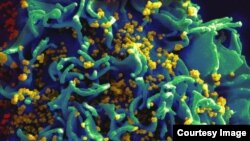WASHINGTON —
Researchers have designed a synthetic molecule that tricks the AIDS virus into destroying itself. The compound, called DAVEI, was developed by researchers at Philadelphia’s Drexel University and causes the deadly pathogen to eject its contents before it can infect human cells.
The AIDS virus uses protein spikes on its surface to fuse to healthy cells. Once attached, the microbe inserts its genetic material, turning the cells into little factories that crank out thousands of copies of HIV.
But DAVEI hijacks the virus, mimicking its interaction with immune system cells. DAVEI binds to the pathogen's outer coat, triggering a firing mechanism that breaches the wall of the AIDS virus, according to Irwin Chaiken, a researcher in the Department of Biochemistry and Molecular Biology at Drexel’s College of Medicine.
Explaining how DAVEI works, Chaiken said, “so that the contents that are inside the virus that are small enough to go through the pores will go through the pores and leak out. And at that point, the virus shrinks and it becomes inactivated.”
DAVEI was designed by Cameron Abrams, a professor of engineering at Drexel. Abrams envisions using the synthetic agent in a microbicide, a cream or gel that women can use vaginally to protect themselves from contracting the disease from their HIV-infected partners.
“And so this we think this would benefit primarily populations in sub-Saharan Africa where male-to-female transmission is very high rate, young women are being infected at a very high rate. That’s extremely detrimental to those societies,” said Abrams.
Abrams also says DAVEI might be used someday as a treatment for those who are HIV positive by destroying infected cells.
“In an active infection in an individual, there are cells that are continuously producing virus. And if those cells could be destroyed before they produce a lot of virus that obviously would be very good,” Abrams pointed out.
Researchers say much more work needs to be done with DAVEI and compounds like it before actual anti-HIV therapies could be developed. An article on the manmade molecule was published in the October edition of Antimicrobial Agents and Chemotherapy.
The AIDS virus uses protein spikes on its surface to fuse to healthy cells. Once attached, the microbe inserts its genetic material, turning the cells into little factories that crank out thousands of copies of HIV.
But DAVEI hijacks the virus, mimicking its interaction with immune system cells. DAVEI binds to the pathogen's outer coat, triggering a firing mechanism that breaches the wall of the AIDS virus, according to Irwin Chaiken, a researcher in the Department of Biochemistry and Molecular Biology at Drexel’s College of Medicine.
Explaining how DAVEI works, Chaiken said, “so that the contents that are inside the virus that are small enough to go through the pores will go through the pores and leak out. And at that point, the virus shrinks and it becomes inactivated.”
DAVEI was designed by Cameron Abrams, a professor of engineering at Drexel. Abrams envisions using the synthetic agent in a microbicide, a cream or gel that women can use vaginally to protect themselves from contracting the disease from their HIV-infected partners.
“And so this we think this would benefit primarily populations in sub-Saharan Africa where male-to-female transmission is very high rate, young women are being infected at a very high rate. That’s extremely detrimental to those societies,” said Abrams.
Abrams also says DAVEI might be used someday as a treatment for those who are HIV positive by destroying infected cells.
“In an active infection in an individual, there are cells that are continuously producing virus. And if those cells could be destroyed before they produce a lot of virus that obviously would be very good,” Abrams pointed out.
Researchers say much more work needs to be done with DAVEI and compounds like it before actual anti-HIV therapies could be developed. An article on the manmade molecule was published in the October edition of Antimicrobial Agents and Chemotherapy.





